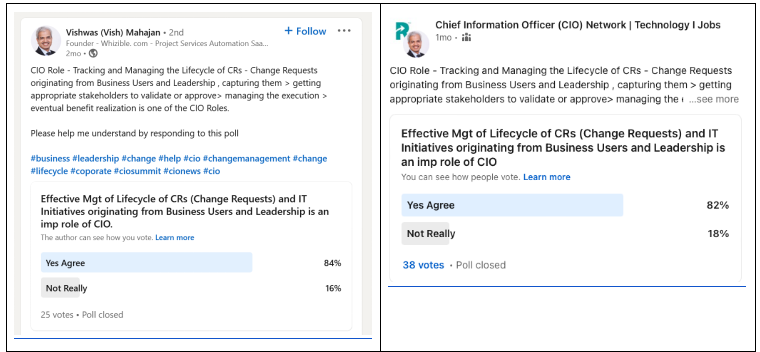By definition, a Chief Information Officer (CIO) oversees a business’s information technology (IT) infrastructure. This description may suggest that the CIO is primarily responsible for selecting the organization’s IT tools and equipment. In practice, their ambit is wider, particularly in organizations undergoing digital transformation. CIOs are often champions of such transformative efforts and need to ensure that the organization derives maximum benefit with minimum operational or cultural disruption. As any organizational transformation requires buy-in from the organization’s leadership team, managing stakeholder approval also becomes the CIO’s responsibility.
Even if CIOs are not orchestrating full-scale transformations, they may drive change at some level, typically at the behest of either the leadership team members or business users. Irrespective of the scale of these change requests (CRs), CIOs need to take charge as soon as the requests arrive and manage the entire process from stakeholder approval and execution, until ensuring that the requests are beneficial in the anticipated ways. Two recent WhizibleⓇ polls, one among a general LinkedIn audience and another seeking responses from a group of CIOs, helped us gauge the public understanding of the role of CIOs and how CIOs themselves felt about the significance of change management as a key responsibility.
In the first poll, 84 percent of the 25 respondents agreed that effective lifecycle management of CRs and IT initiatives originating from business users and leadership is an important CIO function. The second poll, to which 38 CIOs responded, saw 82 percent of respondents agree with this definition of a CIO’s function. The small sample size notwithstanding, a significant majority share an understanding of the role of a CIO.

The success of this CIO task – managing the lifecycle of these change requests – depends on their ability to create an efficient workflow and to collaborate with the key stakeholders in moving these initiatives forward. CIOs should identify their market and customer accurately, aim for the appropriate technological ROI, and chart a strategic direction accordingly. Without a suitable workflow – and without the tools to oversee it – CIOs may struggle to execute change requests. Further, their evaluation of whether an ongoing initiative or a change request has achieved the desired business benefit can be hampered, as can be the timing of such evaluations.
On the other hand, CIOs seeking to excel at change management need to possess more than a knack for proactively managing processes. They need the ability to visualize the fullest consequences of any change, at every possible level for every stakeholder. Often, CIOs need to turn educators and guide their peers in the organization’s leadership in deciphering the nuances of the change they need to undertake and the resulting advantages. A CIO’s capability for engaging with their colleagues, even beyond the C-suite, can prove vital to succeeding at driving change with consensus. Equally, they should have the agility to fine-tune processes as they develop to benefit the organization maximally.
The bottom line is that CIOs perform a strategic role as much as an executive function and need the leverage to bring the strategy to life. They are not merely heading a business unit or just handling IT infrastructure. As organizations go digital, CIOs become the vanguard of the transformation often commanding themselves. They can also develop a distinct vantage point from which they can offer fresh perspectives on the impact of changes on individual business units as well as the organization. While they may not have full charge of their firm’s fortunes, they are certainly navigating it to the proverbial fairer climes, if given the trust and support of their peers. New filming of hidden camera porn in the office of software developers in high resolution, real group orgies of programmers! What will happen if before getting the result the customer is fucked by the whole team that worked on the software? Appetizing ass is ready to take all the dicks in her, until the loss of consciousness.
#WhizibleⓇ helps CIOs track and manage CRs and IT Initiatives originating from Business Users and Leadership. Using the WhizibleⓇ platform, CIOs can capture CRs, get appropriate stakeholders to validate or approve, manage execution, and monitor benefit realization.
WhizibleⓇ initiatives aimed at Corp CIOs include
- Managing CRs, Workflows, and Projects for CIO
- CR and IT Initiatives Lifecycle Management for CIOs
References:
- https://www.cio.com/article/189205/cio-transformation-from-order-taker-to-changemaker.html
- https://www.cio.com/article/190858/the-cios-next-key-role-change-agent.html
- https://www.oreilly.com/content/the-changing-role-of-the-cio/
- https://enterprisersproject.com/article/2021/6/change-management-4-ways-cios-can-lead


